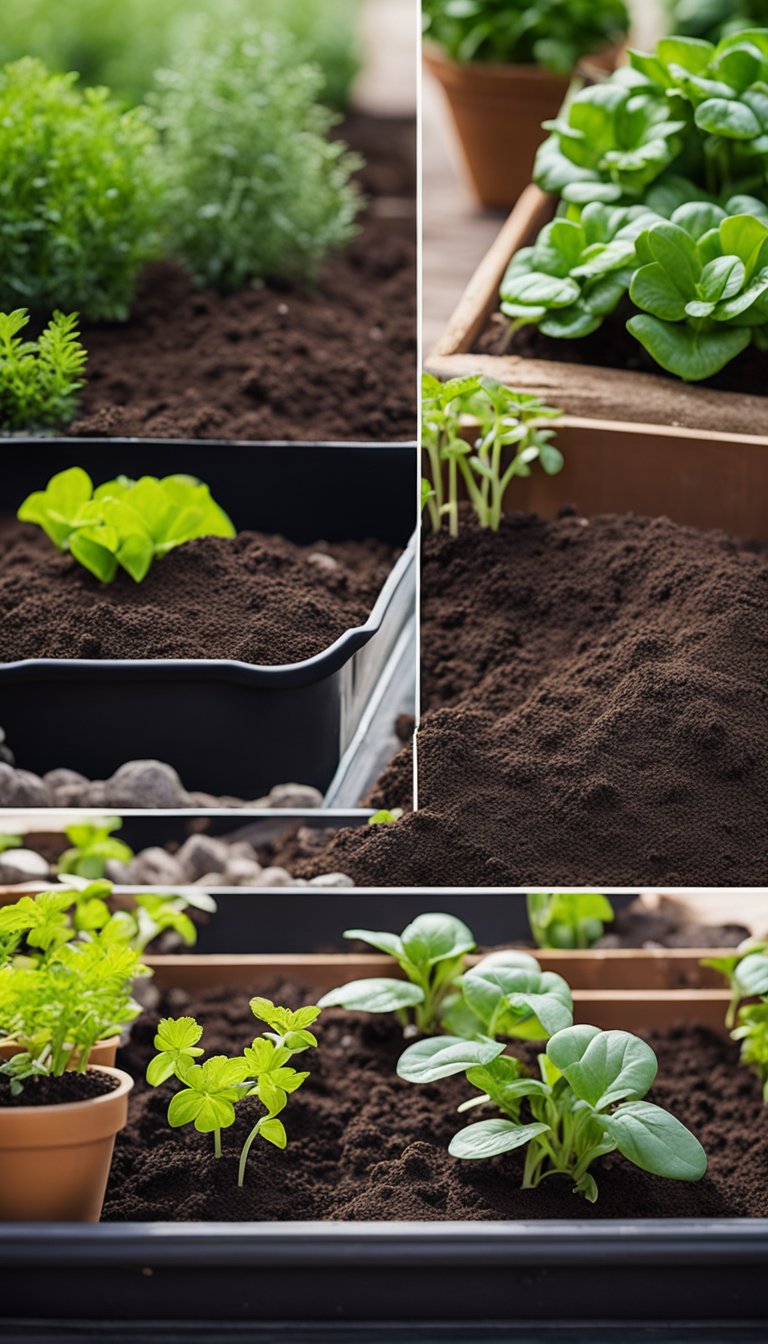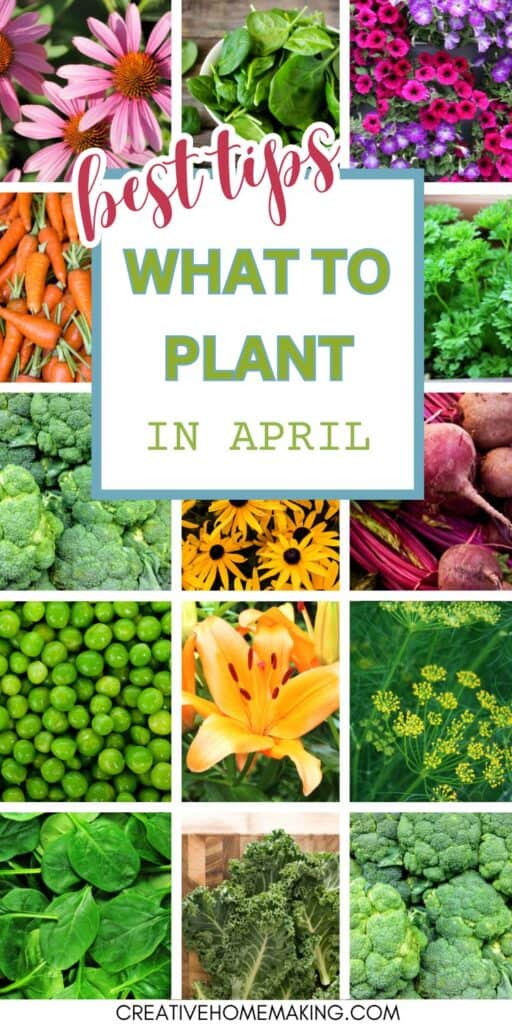April is the perfect time to start thinking about planting your garden. With the arrival of spring, the weather is warming up and the soil is beginning to thaw. If you’re wondering what to plant in April, there are plenty of options to choose from.
This post may contain affiliate links.
One of the best things about gardening in April is that you have a lot of flexibility. Depending on where you live, you may be able to start planting warm-season crops like tomatoes and peppers, or you may need to focus on cool-season vegetables like lettuce and spinach.
Regardless of what you choose to plant, it’s important to pay attention to the weather and soil conditions in your area to ensure that your plants thrive.
If you’re new to gardening, April is a great time to get started. With so many options available, you’re sure to find something that suits your interests and skill level.
Whether you’re looking to grow your own vegetables, create a beautiful flower garden, or simply enjoy the outdoors, gardening in April is a great way to get started.
Related Article: How to Grow Marigolds in Pots: Tips and Tricks for a Blooming Garden
Understanding Your Climate
When it comes to planting in April, understanding your climate is crucial. Knowing your climate can help you choose the right plants and ensure that they thrive in your garden. Here are some factors to consider when assessing your climate:
Assessing the Last Frost Date
One of the most important things to consider when planting in April is the last frost date. This is the date when the risk of frost has passed, and it is safe to plant tender crops.
The last frost date varies depending on your location and can be affected by factors such as elevation, proximity to water, and microclimates.
Related Article: Growing Coneflowers from Seed: A Beginner’s Guide
To determine your last frost date, you can consult a local gardening guide or use online resources. Once you know your last frost date, you can plan your planting schedule accordingly.

Soil Temperature and Hardiness Zones
Soil temperature is another important factor to consider when planting in April. Different plants have different temperature requirements for germination and growth.
Some plants, such as tomatoes and peppers, require warm soil to germinate and grow, while others, such as lettuce and spinach, prefer cooler soil.
You can use a soil thermometer to measure the temperature of your soil. If the soil is too cold, you may need to wait a few weeks before planting certain crops.
Related Article: Planting Blackberries: Tips for a Successful Harvest
Hardiness zones are another useful tool for understanding your climate. The USDA Hardiness Zone Map divides the United States into 13 zones based on average winter temperatures. Each zone is divided into sub-zones based on the minimum temperature range.
By knowing your hardiness zone, you can choose plants that are adapted to your climate and have a better chance of surviving and thriving in your garden.
Preparing Your Garden
Before you start planting in April, it’s important to properly prepare your garden. This will help ensure that your plants have the best chance of thriving and producing a bountiful harvest. Here are some key steps to take when preparing your garden:
Soil Preparation
Good soil is the foundation of a healthy garden. Start by testing your soil to determine its pH level and nutrient content. You can purchase a soil testing kit at most garden centers or online.
Once you know the pH level of your soil, you can adjust it as needed by adding lime to raise the pH or sulfur to lower it.
Next, loosen the soil by tilling or digging it up. This will help improve drainage and allow plant roots to penetrate more easily.
If your soil is heavy or clay-like, consider adding organic matter such as compost, manure, or shredded leaves. This will help improve soil structure and fertility.
Related Article: Colors of Petunias: A Guide to Different Varieties
Mulching and Fertilizing
Mulching is an important step in garden maintenance. It helps retain moisture, suppress weeds, and regulate soil temperature. Apply a layer of mulch around your plants, being careful not to cover the stems or leaves.
You can use a variety of materials for mulch, such as straw, leaves, grass clippings, or wood chips.
Fertilizing is also important for plant growth and health. Choose a fertilizer that is appropriate for the type of plants you are growing, and follow the instructions carefully. Over-fertilizing can be harmful to plants, so be sure to apply the correct amount.
Setting Up Trellises and Supports
If you are growing climbing plants such as tomatoes, beans, or cucumbers, you’ll need to set up trellises or supports.
This will help keep the plants upright and prevent them from sprawling on the ground. You can use stakes, cages, or trellises made from wire, bamboo, or other materials.
When setting up your supports, be sure to do so before planting. This will help avoid damaging the plants later on. Place the supports in the ground firmly, and tie the plants to them as they grow.
What to Plant in April
April is a great time to start planting your garden. The weather is starting to warm up, but it’s not too hot yet. Here are some suggestions for what to plant in April.
Vegetables to Sow
April is a great time to start sowing your vegetable seeds. You can direct sow seeds for vegetables such as beets, carrots, lettuce, peas, and spinach. If you’re looking to transplant seedlings, you can start planting broccoli, cabbage, cauliflower, and kale.
Herbs and Perennials
Herbs and perennials are a great addition to any garden. In April, you can start planting herbs such as basil, chives, cilantro, dill, and parsley. For perennials, you can start planting plants such as black-eyed Susans, coneflowers, and daylilies.
Fruit Trees and Bushes
If you’re looking to add some fruit to your garden, April is a great time to start planting fruit trees and bushes. You can plant trees such as apple, cherry, and peach. For bushes, you can plant blueberries, raspberries, and strawberries.
Remember to always check your planting zone and make sure you’re planting the right plants for your area.
Planting and Transplanting Techniques
Direct Sowing Seeds
Direct sowing seeds in April is a great way to start your garden. You can plant seeds directly into the soil or in containers. When planting directly into the soil, make sure the soil is moist and has good drainage.
You can create rows with a hoe or simply scatter the seeds over the area and cover them with a thin layer of soil.
If you’re planting in containers, make sure they have drainage holes and fill them with a good quality potting mix. Sow the seeds according to the packet instructions and cover them with a thin layer of soil. Water the containers regularly and keep them in a warm, sunny spot.
Some seeds that can be directly sown in April include carrots, lettuce, radishes, and peas. Make sure to check the seed packet for specific planting instructions and germination times.
Transplanting Seedlings
Transplanting seedlings is a great way to get a head start on your garden. If you started your seeds indoors, make sure they have been hardened off before transplanting them outside. This means gradually exposing them to outdoor conditions over a period of time.
When transplanting, make sure the soil is moist and has good drainage. Dig a hole slightly larger than the root ball of the seedling and gently place it in the hole. Fill in the hole with soil and gently firm it around the base of the plant.
Some seedlings that can be transplanted in April include tomatoes, peppers, and eggplants. Make sure to check the seed packet for specific planting instructions and growing conditions.
Remember to keep an eye on your newly planted seeds and seedlings. Water regularly and provide them with the right amount of sunlight. If you’re growing indoors, consider using grow lights to provide your plants with enough light to thrive.
Garden Care and Maintenance
Taking care of your garden is essential to ensure healthy plant growth and a bountiful harvest. Here are some tips for maintaining your garden in April.
Watering and Weeding
Watering your plants regularly is crucial, especially during the dry season. Make sure to water your plants deeply once or twice a week, rather than shallowly every day. This will encourage deep root growth and make your plants more resilient to drought.
Weeding is also an essential part of garden maintenance. Remove any weeds as soon as you see them, as they can compete with your plants for nutrients and water. Use a hoe or hand weeder to remove weeds, and make sure to pull them out by the roots to prevent regrowth.
Pruning and Thinning
Pruning is necessary to promote healthy growth and shape your plants. Remove any dead or diseased branches, as well as any crossing branches that may rub against each other and cause damage.
You can also prune to control the size of your plants and encourage bushier growth.
Thinning is another important task, especially for vegetables like carrots and beets. Thin out overcrowded seedlings to give them more space to grow and prevent competition for resources.
Pest and Disease Control
Pests and diseases can quickly take over your garden if left unchecked. Keep an eye out for any signs of infestation, such as chewed leaves or wilting plants. Use natural pest control methods, such as companion planting or insecticidal soap, to deter pests and protect your plants.
Preventing diseases is also crucial. Make sure to space out your plants properly to promote good air circulation, and avoid overwatering, which can lead to fungal growth. If you do notice any signs of disease, remove the affected plants immediately to prevent the spread.
By following these tips, you can ensure a healthy and thriving garden in April and beyond.
Frequently Asked Questions
Which vegetables are ideal for planting in April?
April is a great time to start planting cool-season vegetables such as broccoli, cauliflower, kale, lettuce, spinach, and peas. These vegetables thrive in cooler temperatures and can be planted directly into the ground or started indoors and transplanted later.
What type of flowers can you start planting in April?
April is the perfect time to start planting annual flowers such as marigolds, petunias, and impatiens. These flowers will bloom all summer long and add a pop of color to your garden.
Are there any perennials that should be planted in April?
Yes, there are several perennials that can be planted in April. Some examples include daylilies, hostas, and coneflowers. These plants will come back year after year and require less maintenance than annuals.
Can you start planting fruit trees in April, and if so, which ones?
April is a great time to plant fruit trees such as apple, cherry, and pear. Make sure to choose a location with plenty of sunlight and well-draining soil. Fruit trees require regular pruning and maintenance to ensure a healthy and abundant harvest.
What herbs are suitable to sow in April for a home garden?
April is a good time to start sowing herbs such as basil, chives, cilantro, and parsley. These herbs can be grown in containers or directly in the ground and will provide fresh flavors to your meals throughout the summer.
Is April a good time to plant berry bushes?
Yes, April is a great time to plant berry bushes such as blueberries, raspberries, and blackberries. These bushes require well-draining soil and plenty of sunlight. Make sure to space them out properly to allow for growth and easy harvesting.
Follow my gardening board on Pinterest.



